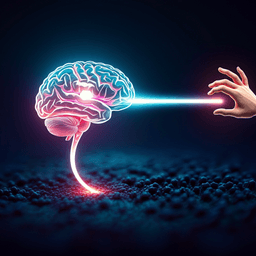
Psychology
Distinct patterns of connectivity with the motor cortex reflect different components of sensorimotor learning
C. N. Areshenkoff, A. J. D. Brouwer, et al.
Human fMRI reveals three distinct axes of connectivity between motor cortex and other brain regions during sensorimotor adaptation, each uniquely linked to implicit learning, performance errors, or explicit strategy use, and situated at increasing cortical hierarchy levels. Only the Explicit axis—a network of higher-order transmodal areas—predicts performance in a separate explicitly driven motor task. This research was conducted by Corson N. Areshenkoff, Anouk J. de Brouwer, Daniel J. Gale, Joseph Y. Nashed, Jonathan Smallwood, J. Randall Flanagan, and Jason P. Gallivan.
~3 min • Beginner • English
Introduction
Human motor learning arises from at least two concurrent processes: a slow, implicit system that updates internal models linking motor commands to sensory outcomes, and a fast, explicit system involving conscious strategic adjustments. Traditional views emphasized a single implicit process, but behavioral and computational work shows parallel implicit and explicit contributions. Disentangling their neural substrates is challenging because performance reflects both processes and additional factors such as error-related feedback. Implicit adaptation has been linked to cerebellar and sensorimotor cortical circuits, whereas explicit strategy use may recruit higher-order association cortex, including prefrontal regions. The present study asks how whole-brain functional connectivity with primary motor cortex (M1) reorganizes during visuomotor adaptation to reflect implicit learning, explicit strategy, and performance (errors), and whether such connectivity patterns generalize to a separate reward-based motor learning task that relies primarily on explicit processes.
Literature Review
Prior work frames implicit sensorimotor adaptation within optimal feedback control, emphasizing updates to internal forward models via sensory prediction errors, implicating cerebellum and parietal-premotor networks. Explicit learning has been associated with prefrontal cortex and executive functions (working memory, attention), yet it is unclear if PFC activity reflects strategy formation or performance-related factors (e.g., reduced errors). Lateral PFC often increases during early adaptation, fueling interpretations of explicit involvement, but conflation with performance monitoring persists. The cortical hierarchy from unimodal (sensorimotor/visual) to transmodal (default mode network, DMN) supports processing over increasing temporal windows; thus, explicit strategy formation may rely on transmodal regions that integrate information across trials. The literature also indicates that reward-based motor learning typically depends on explicit processes when sensory error feedback is unavailable, suggesting potential generalization of explicit-related neural patterns across tasks.
Methodology
Participants: Forty-six right-handed adults completed three sessions (mock MRI training plus two MRI sessions). Ten were excluded (excess motion, task interruption, poor behavioral performance, or failure to perform reward task), yielding N=36 for analyses.
Tasks: (1) Visuomotor rotation (VMR) adaptation in the scanner: After baseline (40–64 trials), subjects performed 160 learning trials with a 45° clockwise cursor rotation requiring a 45° counter-clockwise re-aim to hit the target. After learning, 16 report trials were used to capture explicit aim direction with a left-hand dial before executing the right-hand reach; the final 8 report trials were used to estimate explicit strategy. Explicit learning was defined as the mean angular difference between reported aim and target; implicit learning as the mean difference between actual reach direction and reported aim. Task performance was indexed by early error (mean error over the first 100 imaging volumes ≈ first 32 trials). Behavioral validations included correlations between reported explicit knowledge and response time (RT) during early (r=0.45, p=0.006) and late learning (r=0.69, p=2.57e−06) and RT–error quantile analysis showing negative RT–error correlations in explicit learners compared to implicit learners (mexp = −0.44 vs mimp = 0.11, p=0.033). A separate behavioral study (N=14) with interspersed report trials confirmed stability and early emergence of explicit re-aiming and high correlation between early and late explicit reports (r=0.77, p=0.0012).
(2) Reward-based motor learning task in a separate MRI session: Subjects traced a visible rightward curved path without cursor feedback. During learning (200 trials), scalar reward (0–100) was provided based on accuracy relative to the hidden mirror-image path (unbeknownst to participants), precluding sensory error-based learning. A baseline block (70 trials) had no scores. Trial-by-trial lateral movement scores (left/right bias) were fit with a sigmoid (Bayesian regularization via Stan) to derive lower/upper asymptotes (L, U), midpoint m, and learning rate k; pre-learning, learning, and post-learning epochs were delimited by quantiles of the fitted curve.
MRI acquisition and preprocessing: Data were collected on a 3T Siemens Trio with standard EPI parameters (TR=2s; whole-brain coverage). Preprocessing employed fMRIPrep 1.4.1 (motion correction, slice-time correction, normalization, ICA-AROMA denoising, CompCor, confounds). ROIs: cortical Schaefer-400 parcellation assigned to Yeo 17 networks; cerebellar atlas (Diedrichsen); striatal regions from Harvard–Oxford; hand/tongue motor parcels identified per functional localizations reported in Schaefer et al. ROI time series were averaged per parcel.
Connectivity estimation and centering: For each subject, covariance matrices (Ledoit–Wolf shrinkage) were estimated for equal-length epochs (100 volumes) during baseline, early learning, and late learning in VMR; and for pre-learning, learning, post-learning in reward task. To remove dominant subject-level static connectivity and align task-related variance, covariance matrices were centered on the Riemannian manifold: computing subject and grand means, projecting to the tangent space at subject mean, then transporting to the grand mean (implemented in R package spdm). Analyses focused on bipartite connectivity between left-hemisphere hand M1 and all other ROIs.
Learning-related neural axes: To isolate neural correlates of explicit, implicit, and performance components during early VMR learning, the study regressed out early error from both behavioral explicit/implicit measures and ROI–M1 connectivity features, yielding performance-corrected explicit and implicit targets; a separate model targeted performance (negative error, so higher denotes better). Group-regularized ridge regression (GRridge) with network-specific penalties (17 groups: 15 cortical networks + cerebellum + basal ganglia) was trained on early-learning connectivity to predict each component. Leave-one-out cross-validation tuned penalties. Resulting ROI coefficient maps defined three axes: Explicit, Implicit, and Performance.
Generalization analysis: For each subject and reward-task epoch, spatial correlations between that epoch’s whole-brain M1 connectivity pattern and each VMR-derived axis provided axis expression scores. Correlations between learning-epoch expression changes and reward-task learning rates tested cross-task predictive validity. Control analyses repeated axis construction using ipsilateral/contralateral tongue areas and ipsilateral hand M1, and using late-learning VMR connectivity to test whether effects reflected strategy implementation rather than strategy learning.
Additional details: Extensive acquisition parameters, preprocessing steps, behavioral trial structure, and statistical modeling (including priors for sigmoid fitting, convergence diagnostics, and epoch definitions) are reported. Code and data are available via OpenNeuro (ds005598) and linked repositories.
Key Findings
- Three distinct connectivity axes with M1 during early VMR learning were identified and predicted their respective behavioral components with good cross-validated performance: Explicit axis (R²=0.29), Performance axis (R²=0.82), and Implicit axis (R²=0.64).
- Network associations:
- Implicit axis: strongest loadings in dorsal attention network (DAN-B), including superior parietal and premotor cortices; anterior motor cerebellar regions showed alignment in a cerebellum-focused analysis.
- Performance axis: strongest in frontoparietal Control-A subnetwork (DLPFC, inferior parietal lobe, anterior cingulate), consistent with error detection/goal-directed spatial attention.
- Explicit axis: strongest in default mode network (DMN-B), including middle/inferior frontal gyrus, angular gyrus, and anterior/middle temporal cortex.
- Cross-loading was generally sparse; notable cross-loadings occurred in Control-A/C subnetworks, with posterior cingulate cortex and precuneus showing strong explicit alignment.
- Hierarchical organization: Axis loadings varied along the principal cortical gradient (from unimodal to transmodal). An explicit-vs-implicit alignment summary (rank difference per ROI) correlated with the principal gradient (spin-test p=0.028), indicating implicit axis near sensorimotor/unimodal and explicit axis at the transmodal apex (DMN).
- Generalization to reward-based learning: During the reward task’s learning epoch, increased expression of the Explicit axis (derived from VMR) correlated with faster learning rates (r=0.34, t34=2.04, p=0.049). No such relationship for Implicit (r=−0.12, p=0.48) or Performance (r=−0.05, p=0.77) axes, nor during pre-learning (r=−0.06, p=0.74) or post-learning (r=−0.18, p=0.32) epochs.
- Control analyses:
- Re-deriving axes using ipsilateral hand, or contra-/ipsilateral tongue M1 abolished the correlation between explicit axis expression and reward learning rate.
- Axes constructed from late VMR learning did not predict reward-task performance; late explicit axis shifted to DAN/visual regions (premotor, posterior parietal, visual areas), consistent with strategy implementation (e.g., mental rotation) rather than formation.
- Behavioral validations in VMR:
- Explicit reports correlated with RT during early (r=0.45, p=0.006) and late (r=0.69, p=2.57e−06) learning.
- RT–error correlation across quantiles was more negative in explicit learners (mexp = −0.44) than implicit learners (mimp = 0.11), t34 = −2.38, p=0.033.
- Separate behavioral cohort with interspersed reports showed strong correspondence between early and late explicit reports (r=0.77, p=0.0012) and stable explicit awareness across learning.
Discussion
The study disentangles neural substrates of implicit learning, explicit strategy, and performance during visuomotor adaptation by modeling learning-dependent changes in functional connectivity with primary motor cortex. Implicit adaptation mapped onto superior parietal and premotor regions within DAN, consistent with internal model updating and sensory-guided control. Performance-related connectivity localized to the frontoparietal Control network (DLPFC/IPL/ACC), aligning with attention and error-monitoring processes needed for task performance regardless of learning mechanism. Crucially, explicit learning aligned with DMN regions (DMN-B), suggesting that strategy formation engages transmodal, high-level systems capable of integrating information across trials and supporting internally guided rule-sets. The axes’ positions along the principal cortical gradient underscore a hierarchical organization: implicit near unimodal sensorimotor areas, performance in intermediate control systems, and explicit at the transmodal apex. Generalization analyses showed that only the Explicit axis predicted learning in a separate reward-based task lacking sensory error feedback, and only during the active learning period, indicating specificity to strategy learning rather than general or pre/post task states. Control analyses (alternate M1 seeds and late-learning axes) further supported that the identified explicit axis reflects strategy formation processes, distinct from later strategy implementation (e.g., mental rotation) that involved DAN/visual cortices and did not generalize to reward-based learning.
Conclusion
This work establishes a tripartite mapping between functional connectivity with motor cortex and the component processes of sensorimotor learning: an Implicit axis (parietal–premotor/DAN), a Performance axis (frontoparietal control), and an Explicit axis (DMN). These axes occupy successively higher positions along the cortical processing hierarchy and differentially predict behavior. Notably, only expression of the Explicit axis generalizes to and predicts learning in a reward-based motor task that relies on explicit processes. The findings clarify the neural architecture underlying distinct learning components and emphasize the role of transmodal DMN regions in strategy formation. Future research should: (1) examine inter-regional interactions beyond bipartite coupling with M1 (e.g., cortico-cortical and subcortical circuits independent of M1), (2) improve sensitivity to cortico-cerebellar/striatal connectivity, (3) delineate specific cognitive operations (e.g., hypothesis testing, credit assignment, memory-guided exploration) constituting explicit motor learning across tasks and timescales, and (4) test causal contributions via neuromodulation or lesion studies.
Limitations
- Analyses focused on bipartite connectivity between motor cortex and other regions; connectivity changes outside M1-to-region couplings were not assessed, limiting inferences about broader network interactions.
- Cerebellar and striatal regions loaded relatively weakly on axes compared to cortex, likely reflecting weaker BOLD-based functional connectivity, potentially underestimating their roles in learning.
- Late-learning explicit processes indicative of strategy implementation (e.g., mental rotation) were not directly assayed; interpretations rely on known associations of implicated regions.
- Task order was not counterbalanced (reward-based task before VMR); although justified to preserve naïveté in the reward task, order effects cannot be entirely ruled out.
- The sample size, while typical for fMRI, may limit detection of smaller effects and fine-grained subnetwork contributions.
Related Publications
Explore these studies to deepen your understanding of the subject.







